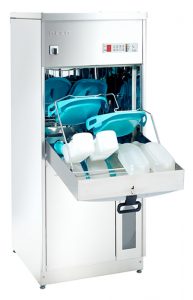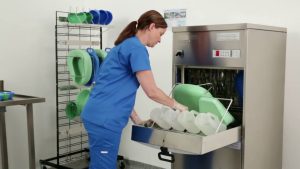 All workplaces require an infection control policy.
All workplaces require an infection control policy.
These policies must be implemented properly so that they do what they are designed for – keeping people safe.
For those working in the health and care sectors, having a robust infection control policy is essential. These settings care for vulnerable people who are more susceptible to catching infections. Anyone with a contagious illness can potentially put other people at risk.
When infections spread through a healthcare setting, they are called HAIs (healthcare-associated infections). Quite rightly, if an outbreak occurs, questions need to be answered, and policies and procedures must be reviewed. People want to be able to trust their healthcare providers. They want to feel safe when in hospital.
Elderly people and their families want to know care homes are protecting them. Pet owners want to be reassured that their beloved animals will be safe. Any infection outbreak can cause mistrust which could take a long time to regain.
To make sure your infection policy is working, you should carry out regular risk assessments to check.
Here are some of the questions you should ask yourself:
- Where could potential outbreaks occur?
- Where is cross-contamination more likely?
- Who could be harmed as a result of an outbreak?
- Is the risk low, medium or high? Do staff know the difference?
- Is equipment reusable? How is it cleaned?
- How can this information be communicated to staff?
 What’s the difference between high, medium and low risk?
What’s the difference between high, medium and low risk?
Different levels of risk should be treated in different ways. Let’s take reusable equipment as an example. Your infection policy will define the risk level of each item, and they will be cleaned and stored appropriately.
Low Risk
These are items that are in contact with healthy skin or not in contact with a patient. These can include bed frames, wheelchairs and toilet seats. Normal cleaning after each use is usually sufficient but disinfecting may be needed if there is an infection outbreak.
Medium Risk
Bedpans and flexible endoscopes are usually classed as medium risk items. They come into contact with mucous membranes and can be contaminated with readily transmissible microorganisms. These items should be cleaned, disinfected and sometimes sterilised before being re-used. Washer disinfectors are recommended as they safely dispose of waste and clean and disinfect in a contained environment.
High Risk
Surgical equipment is high risk as it comes into close contact with mucous membranes and is used where there is a break in the skin. This type of equipment must be cleaned and sterilised after each used and stored in a sterile state.
 Embedding Best Practice
Embedding Best Practice
As you know, risks can change quickly. The pandemic has shown us all that we need to adapt quickly and respond to infection outbreaks appropriately. Don’t forget your main objective is to protect people and keep everyone within your work environment safe.
By embedding best practices into everyday procedures, you’ll be able to maintain a safe and clean environment. This can only be achieved through training, monitoring, surveillance and auditing.
Prioritise Training
Training all staff on infection control procedures is the best way of implementing your policy every day. Even experienced health care workers need reminding. If you make your procedures easy to learn, people are more likely to remember them. Signs for when and how to handwash serves as a simple reminder to everyone. Designated clean and dirty areas that are colour-coded also help prevent cross-contamination. Investing in automated systems like bedpan washers and washer disinfectors can also help staff become more efficient and can help simple mistakes from being made.
Prioritise Staff
 We understand the pressures you and your staff are under. Huge workloads are a strain on your resources. Your team need time for bedside care, paperwork while also dealing with staff shortages. Having a solid infection control policy will help. It reduces the chances of staff illness, and there is also less chance of patients becoming dangerously ill. By preventing these things, you are giving time back to your staff.
We understand the pressures you and your staff are under. Huge workloads are a strain on your resources. Your team need time for bedside care, paperwork while also dealing with staff shortages. Having a solid infection control policy will help. It reduces the chances of staff illness, and there is also less chance of patients becoming dangerously ill. By preventing these things, you are giving time back to your staff.
Prioritise Cleaning
Using a washer disinfector is also another great way to save time and help staff care for patients. They save you time because staff are no longer cleaning by hand. They also help you stop worrying because you know your items are cleaned and disinfected correctly and safe to use again.
If it’s time to renew your infection policy and look at more efficient ways of implementing it, come and talk to us. We’ll guide you through our different washer disinfectors and bedpan cleaners and can help you make the right choice for your staff and your workplace.

 All workplaces require an infection control policy.
All workplaces require an infection control policy.